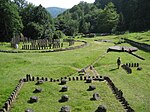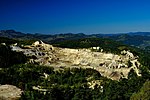羅馬尼亞世界遺產列表
根據聯合國教科文組織(UNSECO)1972年制訂的《保護世界文化和自然遺產公約》,世界遺產是指對全人類有重要文化或自然價值的遺產項目[1]。羅馬尼亞於1990年5月1日接受公約,該國自然和文化遺蹟因此有資格列入《世界遺產名錄》[2]。截至2021年,羅馬尼亞有9項世界遺產,其中7項是文化遺產,2是自然遺產[2] 。
世界遺產[編輯]
聯合國教科文組織根據10項標準收錄世界遺產,入選的每個世界遺產必須符合至少1項標準,其中第一項(i)至六(vi)項為文化遺產;第七項(vii)至第十項(x)則為自然遺產;同時符合文化及自然遺產標準的為複合遺產。順序按入選年份排列[3]。
* 跨國遺產
| 名稱 | 圖像 | 位置(縣份) | 登錄年份 | UNESCO數據 | 資料來源 | 備註 |
|---|---|---|---|---|---|---|
| 多瑙河三角洲 | 
|
圖爾恰縣 | 1991 | 588; vii, x (自然) | [4][5] | |
| 特蘭西瓦尼亞村落及其設防的教堂 | 
|
錫比烏縣、阿爾巴縣、哈爾吉塔縣、布拉索夫縣和穆列什縣 | 1993 | 596bis; iv (文化) | [6] | |
| 霍雷祖修道院 | 
|
沃爾恰縣 | 1993 | 597; ii (文化) | [7] | |
| 北摩爾達維亞的彩色教堂群 | 
|
蘇恰瓦縣 | 1993 | 598bis; i, iv (文化) | [8][9] | |
| 錫吉什瓦拉歷史中心 | 
|
穆列什縣 | 1999 | 902; iii, v (文化) | [10] | |
| 馬拉穆列什的木教堂群 | 
|
馬拉穆列什縣 | 1999 | 904; iv (文化) | [11][12] | |
| 奧勒什蒂耶山脈的達契亞要塞群 | 
|
胡內多阿拉縣及阿爾巴縣 | 1999 | 906; ii, iii, iv (文化) | [13] | |
| 喀爾巴阡山脈原始山毛櫸森林和歐洲其他地區古山毛櫸森林* | 
|
數處 | 2017 | 1133quater; ix (自然) | [14] | 2017年,2021年擴展,由18國共有 |
| 羅西亞蒙大拿礦業景觀 |

|
阿爾巴縣 | 2021 | 1552rev; ii, iii, iv (文化) | [15] | 瀕危遺產[16] |
參考資料[編輯]
- ^ The World Heritage Convention. UNESCO World Heritage Centre. [2020-07-27]. (原始內容存檔於2005-07-02).
- ^ 2.0 2.1 Romania. UNESCO World Heritage Centre. [2021-05-09]. (原始內容存檔於2021-05-10).
- ^ UNESCO World Heritage Centre – The Criteria for Selection. UNESCO World Heritage Centre. [2018-08-17]. (原始內容存檔於2016-06-12).
- ^ Danube Delta. UNESCO World Heritage Centre. [2021-05-09]. (原始內容存檔於2008-01-27).
- ^ Danube Delta Biosphere Reserve. UNESCO World Heritage Centre. [2021-05-09]. (原始內容存檔於2017-01-04).
- ^ Villages with Fortified Churches in Transylvania. UNESCO World Heritage Centre. [2021-05-09]. (原始內容存檔於2021-05-10).
- ^ Monastery of Horezu. UNESCO World Heritage Centre. [2021-05-09]. (原始內容存檔於2021-05-08).
- ^ World Heritage Committee also approves three extensions to World Heritage properties in Austria, Romania and Spain. UNESCO World Heritage Centre. [2010-09-20]. (原始內容存檔於2010-08-05).
- ^ Churches of Moldavia. UNESCO World Heritage Centre. [2021-05-09]. (原始內容存檔於2021-05-09).
- ^ Historic Centre of Sighișoara. UNESCO World Heritage Centre. [2021-05-09]. (原始內容存檔於2019-11-29).
- ^ Wooden Churches of Maramureş. UNESCO World Heritage Centre. [2021-05-09]. (原始內容存檔於2021-05-07).
- ^ Baboș, Alexandru. Tracing a Sacred Building Tradition. Wooden Churches, Carpenters and Founders in Maramureș until the Turn of the 18th Century (學位論文). Lund University. 2004 [2021-05-09]. (原始內容存檔於2021-05-17).
- ^ Dacian Fortresses of the Orastie Mountains. UNESCO World Heritage Centre. [2021-05-09]. (原始內容存檔於2021-05-07).
- ^ Ancient and Primeval Beech Forests of the Carpathians and Other Regions of Europe. UNESCO World Heritage Centre. [2021-02-01]. (原始內容存檔於2012-03-02).
- ^ Roșia Montană Mining Landscape. UNESCO World Heritage Centre. [2021-07-29]. (原始內容存檔於2017-11-13).
- ^ Cultural sites in Africa, Arab Region, Asia, Europe, and Latin America inscribed on UNESCO's World Heritage List. UNESCO World Heritage Centre. [2021-07-29]. (原始內容存檔於2021-07-28).
| |||||||||||||||||||||||||||||||||||||||||||||||||||||||
| ||||||||||||||||||||||||

